Rapes in India: annual statistics
The page that you are on has annual updates. However,
Indpaedia's HOME page on Rape is called Rape in India: longer- term statistics, analyses, and has statistics on
i) Rape in India vis-a-vis other countries;
ii) ‘Stranger rape': in India and other countries;
iii) Statistics about the main cities.
For Child rapes/ Sexual assault on children see Crimes against children: India
Contents |
An Overview
Analysing the 2004-10 statistics
22,172 rapes in 2010; 24,923 in 2012
According to Wikipedia the following number of rapes took place in India in the years between 2004 and 2010.
|
2004 |
2005 |
2006 |
2007 |
2008 |
2009 |
2010 |
|
18233 |
18359 |
19348 |
20737 |
21467 |
21397 |
22172 |
If we take the 2010 figure, the highest of these seven years (2004-2010), it works out to 60.7 rapes a day; 2.53 rapes every hour; or one rape every 23.7 minutes, in a country of 1.2 billion people.
...In per capita terms
HOWEVER, the statistics on the page Rape in India: longer- term statistics, analyses suggest that in per capita terms:
India was not in NationMaster's list of the Worst 50 countries
India was not among HEUNI's worst 28 countries. Indeed, South Asia was the third safest region in the world
The incidence of rape in the UK and USA was 1,500% higher than in India
The Lancet ranked India and Bangladesh among the safest countries in this respect.
Wikipedia's own figures (cited above) indicated that India was safer than most countries
2012
According to India's NCRB there were 24,923 rapes in 2012
How the Delhi gang rape accused were convicted
See graphic:
The dying declaration of the Delhi gang rape victim of 2012
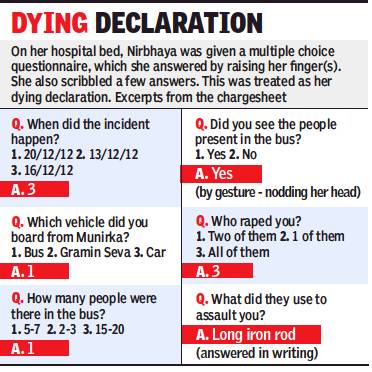
From: Pankhuri Yadav, 2012 rapists were nailed with many policing firsts, December 16, 2017: The Times of India
Battling for life and unable to speak, Nirbhaya’s questioning by a magistrate took the form of multiple choice questions that she answered mostly by raising the required number of fingers — a first-of-its-kind recording of a crime victim’s statement under Section 164 of CrPC.
As per protocol, Nirbhaya first answered a few general questions about herself. She then responded to queries about the events of the fateful night. One of the occasions when she responded with a gesture was when she was asked if she had seen the accused in the bus. Instead of using fingers, she nodded her head.
When asked about what was the object used to assault her, Nirbhaya displayed immense grit to write: “By iron rod lambi si thi”. The next question was about the names her assailants used for themselves. She jotted the names she recalled: Ram Singh, Mukesh, Vinay, Akshay, Vinay and the juvenile’s name.
When asked if she could recognise the accused if they were produced before her, Nirbhaya nodded. The cops showed her a picture, this photo test identification parade being another first. Use of forensic odontology — or analysis of teeth/bite marks — to prove culpability was also a first.
On Friday, Nirbhaya’s father expressed unhappiness about the state of women’s safety in Delhi today. “If Nirbhaya was alive today, we would not send her out in the night. Today, it is routine to hear of gruesome attacks even against children,” he rued.
2012-18
Delhi
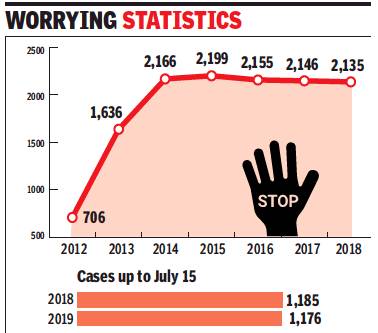
From: August 8, 2019: The Times of India
See graphic:
Rapes in Delhi, 2012-18
2013
2013: Karnataka
Over 1,000 rapes reported in Karnataka in 2013
TNN | Jul 4, 2014
Over 1,000 rapes reported in Karnataka in 2013
Karnataka reported 1,061 cases of rapes in 2013 — the maximum in the last three years.
BANGALORE: The state reported 1,061 cases of rapes in 2013 — the maximum in the last three years. This includes 563 cases of rape on minors. However, only 26 persons were convicted of rape last year. And the number of rape accused convicted in the first half of this year is zero.
The information was provided by home minister KJ George. The first half of 2014 has already reported 476 cases of rapes, including 325 cases of rape on minors.
2013 to March 2018
Rape in Delhi
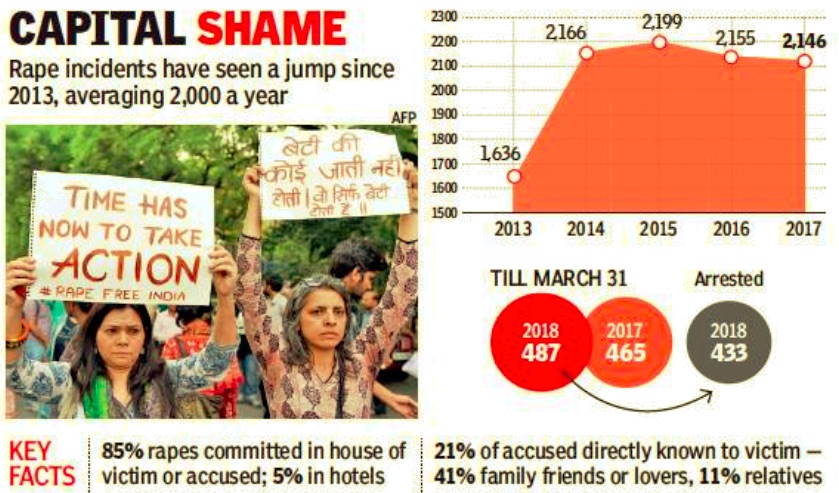
From: Somreet Bhattacharya, April 18, 2018: The Times of India
See graphic:
2013 to March 2018: Rape in Delhi
2013-19
October 6, 2020: The Times of India
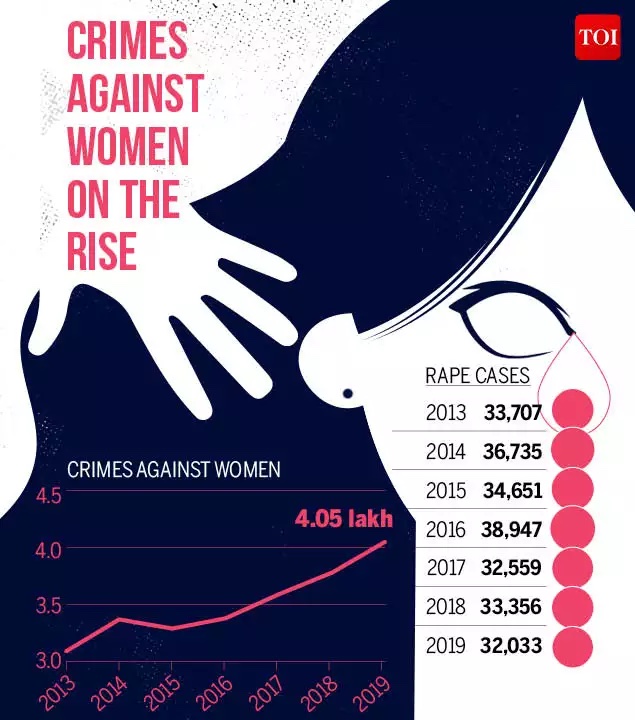
From: October 6, 2020: The Times of India
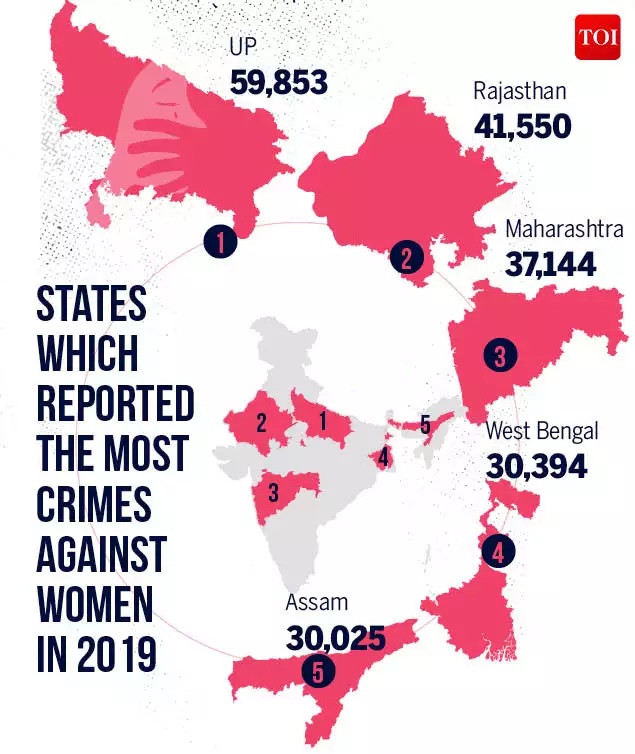
From: October 6, 2020: The Times of India
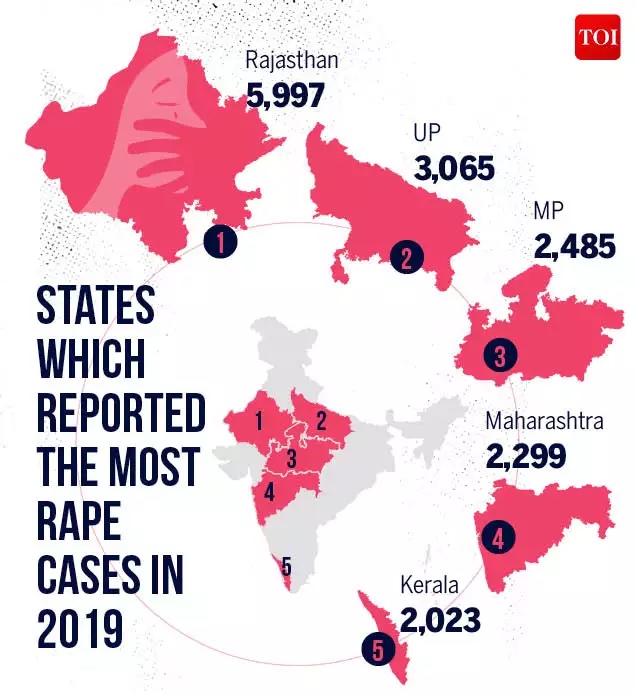
From: October 6, 2020: The Times of India
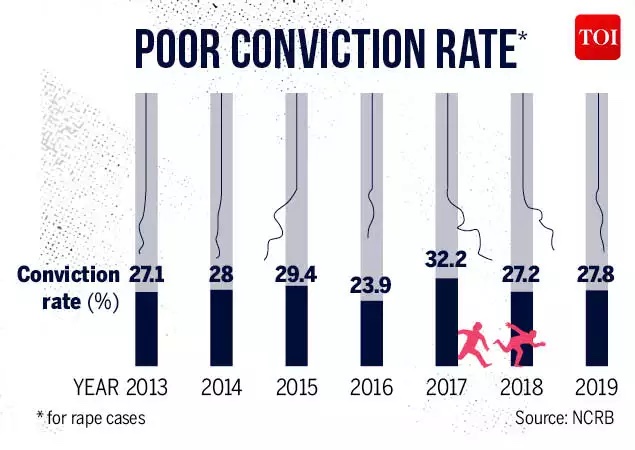
From: October 6, 2020: The Times of India
NEW DELHI: On September 14 this year, a 19-year-old Dalit woman was allegedly gangraped in Uttar Pradesh’s Hathras by four upper-caste men. The incident caused widespread outrage and brought the focus on just how pervasive sexual violence against women is in our country. The woman sustained several injuries and died nearly 14 days later. To make matters worse, the police cremated her in the dead of night without the knowledge and consent of the family.
The Supreme Court termed the incident ‘horrible and shocking’ while hearing a plea for probe by the CBI and SIT into the alleged gangrape.
However, this isn’t the lone incident that has shaken up the country. Several incidences like Nirbhaya rape case (2012), Unnao rape case (2017), Kathaua rape case (2018) and the Hyderabad rape cum murder case (2019) expose the grim reality of bestial sexual crimes against women in the country. A survey by Thomas Reuters Foundation in 2018 ranked India as the most dangerous country for women.
Shocking numbers
Crimes against women have been steadily rising over the years. According to the latest NCRB report, 2019 saw over 4 lakh reported cases of crimes committed against women, up from 3.78 lakh in 2018 and 3.59 lakh cases in 2017.
NCRB reported 32,033 rape cases which translates to a shocking 88 rape cases a day -- and this is just 10% of all crimes against women. Experts say that picture could be far worse as most such crimes go unreported in the country.
Uttar Pradesh holds the worst record
NCRB data shows that in 2019, Uttar Pradesh topped the states in crimes against women with a whopping 59,853 cases, followed by Rajasthan and Maharashtra with 41,550 and 37,144 cases respectively.
Rajasthan tops in rape cases
In terms of rape incidences, Rajasthan fared worst with nearly 6,000 reported cases. Uttar Pradesh ranked second with over 3,000 cases.
No effect of Nirbhaya judgment
The recent incident proves that the execution of the convicts in the Nirbhaya gang-rape and murder case (that took place this year) had no effect on criminals. When the execution took place, it was assumed that it would send a strong message to perpetrators of such crimes, but the recent incidents have proved it otherwise. One reason for this is poor conviction rate and the long road to justice. In 2018 and 2019, the conviction rate for rape was below 30%. Which means out of 100 cases only 30 saw convictions. Absence of forensic labs, fast-track courts and investigators are also partly responsible for this.
2014-19: state-wise complaints received
Rape Cases Reported to NCW
The Sate/UT-wise details of complaints registered by National Commission for Women (NCW), under the category “Rape/Attempt to rape” during 2014-2019 is [in the Table below]. As per the data, maximum numbers of complaints have been received from the States of Uttar Pradesh, Delhi, Haryana, Rajasthan and Bihar.
Table
State/ UT wise Data of complaints registered under the category of Rape/ Attempt to Rape in National Commission for Women (NCW)
|
S. No. |
State |
2014 |
2015 |
2016 |
2017 |
2018 |
2019 |
|
1 |
Andhra Pradesh |
3 |
4 |
4 |
7 |
7 |
2 |
|
2 |
Arunachal Pradesh |
- |
- |
- |
- |
- |
- |
|
3 |
Assam |
3 |
2 |
5 |
2 |
6 |
1 |
|
4 |
Bihar |
50 |
56 |
40 |
48 |
87 |
23 |
|
5 |
Chandigarh |
4 |
1 |
4 |
4 |
1 |
- |
|
6 |
Chhattisgarh |
7 |
13 |
8 |
8 |
11 |
1 |
|
7 |
Dadra and Nagar Haveli |
- |
2 |
2 |
- |
1 |
1 |
|
8 |
Daman & Diu |
|
|
|
|
|
|
|
9 |
Delhi |
147 |
148 |
113 |
96 |
135 |
28 |
|
10 |
Goa |
- |
2 |
1 |
- |
- |
- |
|
11 |
Gujarat |
5 |
13 |
10 |
9 |
11 |
2 |
|
12 |
Haryana |
158 |
116 |
69 |
126 |
166 |
24 |
|
13 |
Himachal Pradesh |
2 |
2 |
6 |
1 |
6 |
3 |
|
14 |
Jammu and Kashmir |
- |
1 |
3 |
4 |
2 |
- |
|
15 |
Jharkhand |
27 |
25 |
11 |
15 |
20 |
4 |
|
16 |
Karnataka |
8 |
10 |
17 |
14 |
17 |
3 |
|
17 |
Kerala |
1 |
3 |
4 |
4 |
9 |
- |
|
18 |
Lakshadweep |
- |
- |
- |
- |
- |
- |
|
19 |
Madhya Pradesh |
73 |
60 |
48 |
41 |
35 |
9 |
|
20 |
Maharashtra |
35 |
28 |
47 |
34 |
25 |
13 |
|
21 |
Manipur |
- |
- |
- |
- |
2 |
- |
|
22 |
Meghalaya |
- |
- |
- |
- |
- |
- |
|
23 |
Mizoram |
- |
- |
- |
- |
- |
- |
|
24 |
Nagaland |
1 |
- |
- |
- |
- |
1 |
|
25 |
Odisha |
8 |
7 |
6 |
10 |
8 |
5 |
|
26 |
Pondicherry |
- |
1 |
- |
- |
- |
- |
|
27 |
Punjab |
17 |
9 |
22 |
22 |
22 |
5 |
|
28 |
Rajasthan |
146 |
142 |
64 |
95 |
112 |
14 |
|
29 |
Sikkim |
- |
- |
- |
- |
- |
- |
|
30 |
Tamil Nadu |
11 |
11 |
24 |
21 |
21 |
6 |
|
31 |
Telangana |
10 |
8 |
10 |
7 |
1 |
5 |
|
32 |
Tripura |
- |
- |
- |
- |
- |
- |
|
33 |
Uttar Pradesh |
1,802 |
1,626 |
809 |
1,027 |
1,333 |
390 |
|
34 |
Uttarakhand |
43 |
26 |
12 |
20 |
22 |
2 |
|
35 |
West Bengal |
14 |
12 |
20 |
22 |
22 |
8 |
Table ends
2014
The Times of India, Aug 08 2015
The minister for women and child development Maneka Gandhi said that there was an increase in the number of sexual offences against children in the country. The number of cases of rape of children had increased from 8,541 in 2012 to 12,363 in 2013 and 13,766 in 2014.
2014: Gang rapes highest in UP
The Times of India, Aug 19 2015
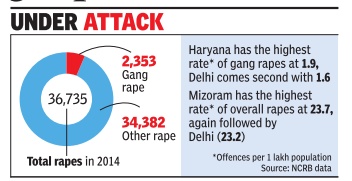
Deeptiman Tiwary
2,300 gang rapes in '14; UP fares worst
The country witnessed over 2,300 gang rapes in 2014, with the highest number of incidents -over 570 -reported in Uttar Pradesh.Haryana and Delhi recorded the highest rate of such offences per one lakh of population at 1.9 and 1.6, respectively. The crime data published by National Crime Records Bureau has for the first time tabulated sexual crimes against women in various categories like gang rape, stalking, voyeurism, sexual harassment at workplace and molestation in public transport.
The decision to collect data on these lines was taken after the 2012 Nirbhaya gangrape incident so as to study the pattern of sexual offences and devise preventive measures. According to the data for 2014, out of over 36,700 rapes recorded in the country , 197 were committed in police custody. Seven of these were gang rapes. UP recorded 189 custodial rapes, accounting for over 90% of the offence.
The data may not reflect the actual scale of such offences or the probability of women suffering such offences in a particular state as NCRB only collects data based on offences registered by the police. Delhi, for example, has shown a spike in cases of crimes against women after the Nirbhaya incident as Delhi Police have ensured that all cases are registered and investigated.The data showed there were over 4,200 cases of attempt to rape as well across India.
Voyeurism
There were 674 cases of voyeurism across India with the highest rate of such cases being reported from Goa, followed by Assam. Over 4,600 cases of stalking were also recorded.
Some rapes given gang rape twist: MSY
SP chief Mulayam Singh Yadav said there were instances where only one person committed rape but the victim named four people merely to settle scores. “Innocents must not be implicated and harassed. There are cases, where a victim has accused four brothers of raping her. It is not practical,“ he added. Mulayam said the rate of rape cases was lowest in UP as compared to other BJP-ruled states.
2015: Age profile of rapists in Delhi
The Times of India, October 12, 2015
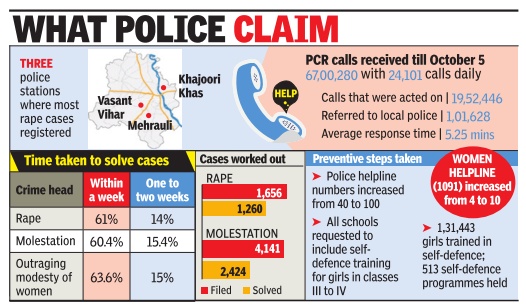
Over half of rape accused aged 18-25 yrs
A study released by Delhi Police commissioner B S Bassi has revealed that most arrested in rape cases in 2015 are in the age group of 1825 years comprising 53% of the total numbers. The data was released during an interaction with women and NGOs and shows that 748 youths of this age group were among 1,427 men arrested for rape. “We have been taking cri mes against women very seriously. We urge women to report any crime committed against them so that quick action can be taken,“ Bassi said.
The data shows 105 accused were aged up to 18 years, while 487 were between 25 and 35. It also found that 647 accused had studied up to Class X, 318 were Class XII passouts and 39 graduates. There were 423 illiterates or school dropouts.
Among those arrested, 38.89% were friends of the sur vivor out of which 25.31% were live-in-relationships in which the accused had refused to marry the woman. The study also shows 16.69% of the accused were neighbours and 14.07 % family members.
Investigations said 85.02% rape cases occurred in houses or jhuggis, 3.38% happened in hotels and restaurants while the rest happened elsewhere. It was also found that 60.83% cases were reported from the poorer strata of the society.
The 2014 National Crime Records Bureau (NCRB) data shows that 71 victims were be ow the age of six, while 806 were between 18 and 30. “In 2015, 9,223 women approached the police control room, 39,502 cal ed the helpline and 25,549 survivors went to the 24X7 police station,“ said Delhi Police spokesperson, Rajan Bhagat.
Police officers said 234 beats with women staff have been formed since 2013 and women cops were specially deployed at 300 bus stops.
Currently , there are 859 patrol vans to assist women travelling late or who are stranded. Police have also deployed motorcycle patrols, emergency response vehicles for women's security . Cops are also posted outside girls' schools and colleges.
Delhi Police has proposed compulsory self-defence training in schools for girls. For safety of women using public transport, police has introduced Special Squad for Women's Protection. This squad travels in civvies to ensure no girl is being harassed in buses. A drive was also launched to catch youths passing lewd remarks and misbehaving with women in buses and public places under operation Shishtachar.
2016
Uttar Pradesh
The Times of India, Aug 03 2016
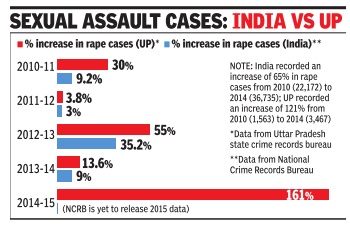
Ishita Bhatia
In UP, rape cases up 161% in a year; 30% spurt in rape bids
At a time when gruesome details of the Bulandshahr gang rape case have ftyk fof shocked the nation and highlighted the issue of lawlessness in Uttar Pradesh, recent statistics show that there has been a 161% rise in rape cases j in just one year (2014 to 2015).
Data released by UP State Crime Records Bureau shows that rape cases have gone up from 3,467 in 2014 to 9,075 in 2015. Not just this, even fnukad & 13 at vx tempt to rape cases have seen a 30% rise. More worryingly , authorities say that this might just be the tip of the iceberg.
According to National Crime Records Bureau's 2014 report, if the national figures are compared with UP-specific statistics, 'kevident it is Jh vf[kys ch oSfj;j that the increase in number of rape cases each year in UP has been more than the countrywide spike -almost twice the national average. While India recorded an increase of 65% in rape cases from 2010 (22,172) to 2014 (36,735), UP recorded an increase of 121% flag 2010 dj from Jh mek'ka (1,563) to 2014 (3,467). NCW chairperson Lalitha Kumaramangalam said, “Quite a number of cases are filed under wrong sections. In the Bulandshahr case too, police had not included POCSO in the FIR. It was only after we it to brought Jh their nhid notice that dqekj it was included.“
Kerala
PTI 910 rape cases reported in Kerala in six months| Oct 31, 2016
Despite stringent laws and awareness campaigns, as many as 910 cases of rape have been reported in Kerala in the first six months of this year, giving an indication of continuing atrocities against women in the state.
A total of 7,909 cases of crimes against women were reported across the state upto July, according to state police's crime statistics. Of them, 2332 were cases of molestation, 190 cases of eve teasing and 78 cases of kidnapping of women besides 910 cases of rape, it said. The number of rape cases reported last year was 1263, it said.
Expressing concern over the alarming figures, state Women's Commission chairperson K C Rosakkutty said awareness seminars and classes were not enough to tackle the increasing atrocities against women. Absence of fast-track courts and speedy trials are among the major challenges in dealing with rape cases, she said.
"In most of the rape cases, we fail in ensuring that the accused gets the right punishment at the right time for the gruesome crime committed.
"The delay in trials and awarding of punishments also contribute to in crease in such cases," Rosakkutty told PTI.
"We have been demanding fast-track courts for years to ensure speedy trial in rape cases. But, it still remains as a demand.The delay in trials gives criminals ample time to escape through the loopholes in law," she said.
Stating that the Women's Commission conducts state-wide seminars and awareness classes regularly, she said such drives were not enough to check the atrocities against women. "Despite all these drives, women are still considered and treated as second grade citizens in our society. This attitude should be changed first. Mothers should be given special awareness to nurture their children as good citizens," she said.
Local bodies and community outfits also have a role to play at the grassroot level to check attacks against women.
According to the statistics, the highest number of crimes against women including rape were reported from the northern district of Malappuram, where as many as 861 cases under various categories were registered during the period.
The total number of rape cases reported from Malappuram was 106, followed by Thiruvananthapuram rural (78) and Ernakulam rural (64), it said.
Malappuram also witnessed highest number of cases in terms of molestation (160) and cruelty by husbands and other relatives (266), the statistics added.
All India
Neeraj Chauhan, 2016 saw 106 rapes a day, December 1, 2017: The Times of India
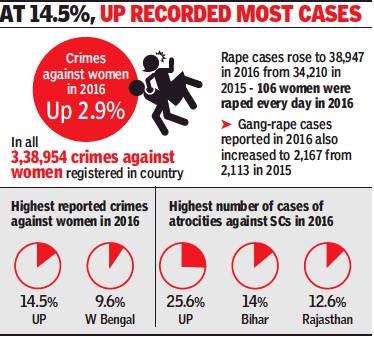
From: Neeraj Chauhan, 2016 saw 106 rapes a day, December 1, 2017: The Times of India
In 2016, India recorded 106 rapes a day, once again highlighting the continuing rise in crimes against women in the country despite a series of court rulings and toughening of laws to deal with the menace.
A large number of those raped (2,116) were girls in the age-group of 0 to 12 years and in 36,859 (94.6%) of cases, offenders were known to the rape victims including neighbours, family members, relatives, husband/live-in partner, employer/co-worker etc.
The national capital Delhi witnessed the most rape cases at 1,996 , followed by 712 in Mumbai, 354 in Pune and 330 in Jaipur. The NCRB data released on Thursday said that crimes against women increased by 2.9% all over the country in 2016 with 4,737 rapes recorded through the year. In all, 38,947 rape cases were registered across India in 2016, compared to 34,210 in 2015.
Gang-rape cases reported in 2016 also increased to 2,167 from 2,113 in 2015.
UP, which was ruled by SP in 2016, reported 14% of crimes (at 49,262 out of 3,38,954 cases, the most) against women, followed by Bengal (9.6%).
Out of the total 3,38,954 crimes against women registered in 2016, most of the women were victims of ‘cruelty by husband or relatives’ (32.6% of cases), followed by ‘assault on women with intent to outrage her modesty’ (25%), ‘kidnapping and abduction of women (19%) and ‘rape’(11.5%).
It turns out that 33,796 women/girls were also kidnapped/abducted in 2016 with the motive of compelling them to marry, with the most such (12,070) cases reported from UP. Police officers say most of the abduction/kidnapping cases of girls who eloped with someone are also registered under kidnapping. The NCRB data reveals that 2,60,304 cases of crimes against women were sent for trial in courts in 2016. Conviction was secured in 23,094 cases. Also reported in 2016 were 206 cases of acid attack on women, while 7,236 women were stalked.
Among 19 metros analysed by NCRB, Delhi, followed by Mumbai and Bengaluru, reported most number of crimes against women — 13,803 out of 41,761, also seeing the most stalking cases at 669.
2015- Jan 2017
Delhi
Despite dip in crime rate, 6 rape cases a day in city, Feb 20, 2017: The Times of India
Even though registration of crimes against women dipped marginally in 2016, Delhi reported six rapes on an average every day , indicating that much more was needed to be done to bring the numbers further down.
In 2017, the numbers have dipped further. Delhi Police registered 140 rape cases in January . Last year, the figure was 147 by January end.
Delhi Police officers said that the dip in crime rates is the result of proactive policing measures. “We conducted street plays, self-defence programmes and awareness campaigns over the course of the year,“ said a senior officer.
According to police data, 96.4% of the accused in rape cases were known to the victims. Overall, Delhi Police registered 2,155 cases of rape in 2016 as against 2,199 registered in 2015.
In the annual review of the cases of crime against women, police said that of all rape and molestation cases registered, 85.09% of rape and 70.60% of molestation were solved within 48 hours. The chargesheets in these cases were also filed within 20 days.
During the crime mapping exercises conducted last year, police found that almost 95% of cases of crime against women were reported from JJ clusters, resettlement colonies and areas where civic amenities were poor.
In 2016, cops registered 4,166 cases of molestation as against the 5,367 registered in 2015. 3,033 cases of molestation were solved in 2016. This year, 238 cases of molestation have been registered so far.
According to the data, cases of abduction of women too witnessed a significant reduction. In 2015, 556 cases of abduction were registered, while 444 cases were reported in 2016.
The best and worst states, 2015-17
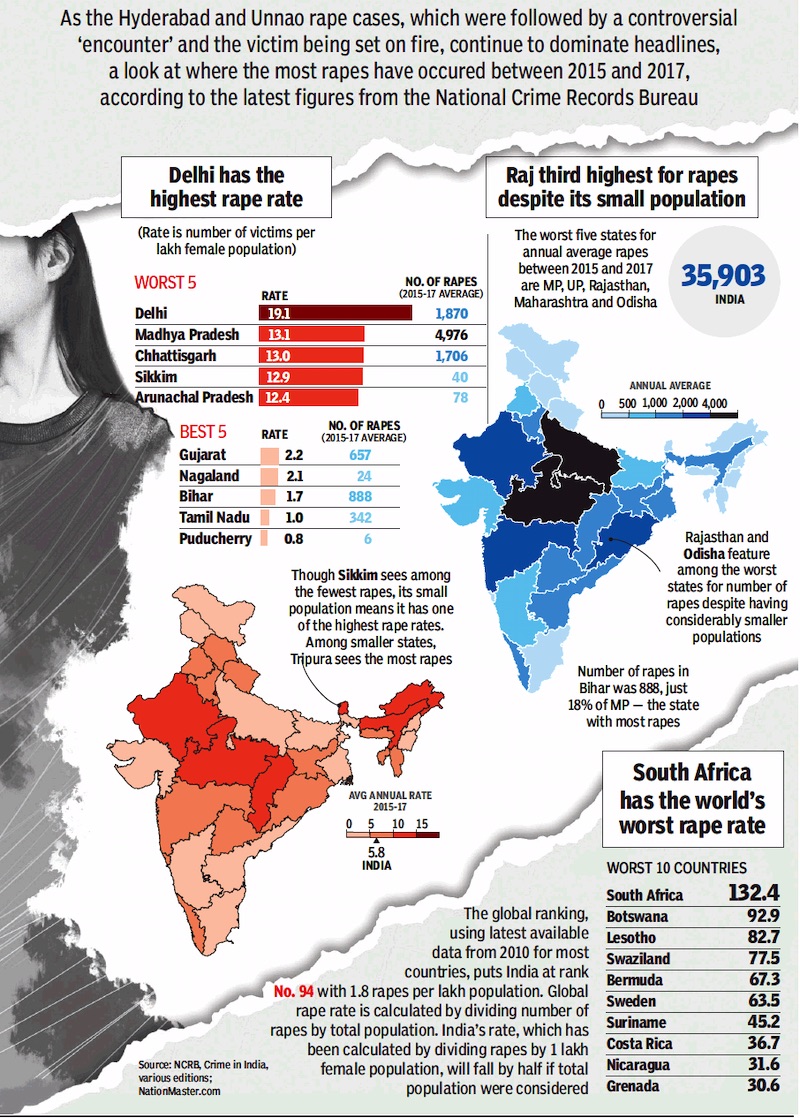
From: Dec 12, 2019: The Times of India
See graphic:
Rapes in India: The best and worst states, 2015-17
2018
Delhi: 43% were raped by family or friends
For a city that was branded as the nation’s “rape capital” in the aftermath of the Nirbhaya incident in 2012, there’s good news for Delhi. Crimes against women remained in check in 2018, according to Delhi Police commissioner Amulya Patnaik. At the annual police press conference on Wednesday, Patnaik pointed out that despite free registration, the city did not witness a rise in number of rapes, recording 2,043 cases in 2018 against 2,059 in 2017.
However, what is even more encouraging, according to the police chief, was that the involvement of strangers in rapes came down to 2.5% of all cases for the first time in 2018. In 2016 and 2017, the figure stood at 3.6% and 3.4%, respectively. The data showed that 2,290 people were arrested for rape last year compared with 2,275 in 2017.
An analysis has revealed that 43.5% of the rape cases involved a family member or a friend of the victim, while 16.3% involved neighbours. Relatives were accused of the crime in 12% of the cases and employers or co-workers in 2.9%. According to police, 550 cases related to those in which the accused and victim were in a live-in relationship or where the accused had refused to marry the victims. In 51 cases, the accused were strangers.
There were 3,175 cases of molestation registered in 2018 against 3,275 in 2017 and 4,032 in 2016, and 3,890 people were arrested under this charge last year.
Cases registered under Section 509 of the Indian Penal Code regarding punishment for outraging a woman’s modesty saw a similar dip. From 894 cases in 2016 and 621 cases in 2017, the figure came down to 569 cases in 2018, while 676 persons were arrested for this crime.
Delhi Police has attributed the fall in incriminating numbers to the measures it took, such as 1,419 self-defence training programmes organised in education institutions or other place in 2018 in which 2,77,516 girls received training. Special commissioner R P Upadhyay said, “Delhi Police entered the Limca Book of Records for having trained 9,80,456 women so far under 5,140 programmes.”
Patnaik also said that there police had emphasised the popularisation of the Himmat Plus app, using which women can make an SOS call at a single click. He also said that various “gender sensitisation and mind-set reformation” drives comprised the police women empowerment project called ‘Sashakti’. Interestingly, 15 all-women police control room vans were operationalised for which 46 female personnel were given training.
The police chief also talked about other initiatives. “We have identified dark stretches and shared the information with the civic agencies,” Patnaik said. “Delhi Police has also requested the state government to strengthen the last-mile connectivity. And then, we have requested the social welfare department to initiate programmes for awareness and education in slums and areas with high incidence of crimes against women. We have also suggested that schools should include self-defence as a part of the curriculum.”
2019
Rajasthan: an 81% increase from 2017
TNN, January 7, 2020: The Times of India
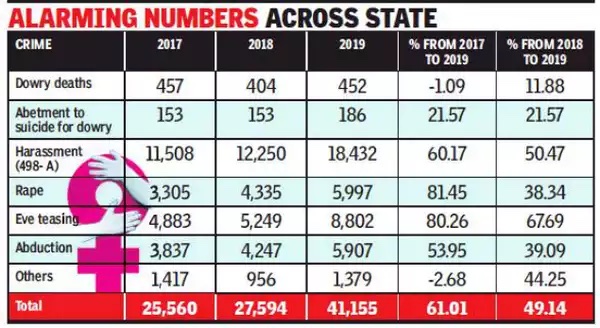
From: TNN, January 7, 2020: The Times of India
JAIPUR: Rajasthan witnessed an alarming rise in the number of rape cases registered across the state, reporting an increase of 81.45 per cent in 2019 when compared to 2017. The crime statistics were released by the state police on Monday. Crimes against women increased by nearly 50 per cent in 2019 compared to the previous year.
While 3,305 rape cases were lodged in 2017, the number rose and touched 4,335 in 2018. In 2019, the registered rape cases reached 5,997. From 2018 to 2019, crimes against women increased by 49.14 per cent in the state. Apart from rape, complaints of harassment and eve-teasing too rose. There was an increase of 22 per cent in rape cases under the Pocso Act.
In 2019, the highest increase was in cases of eve-teasing, which was 68 per cent more than the previous year.
2020
Rape: state-wise
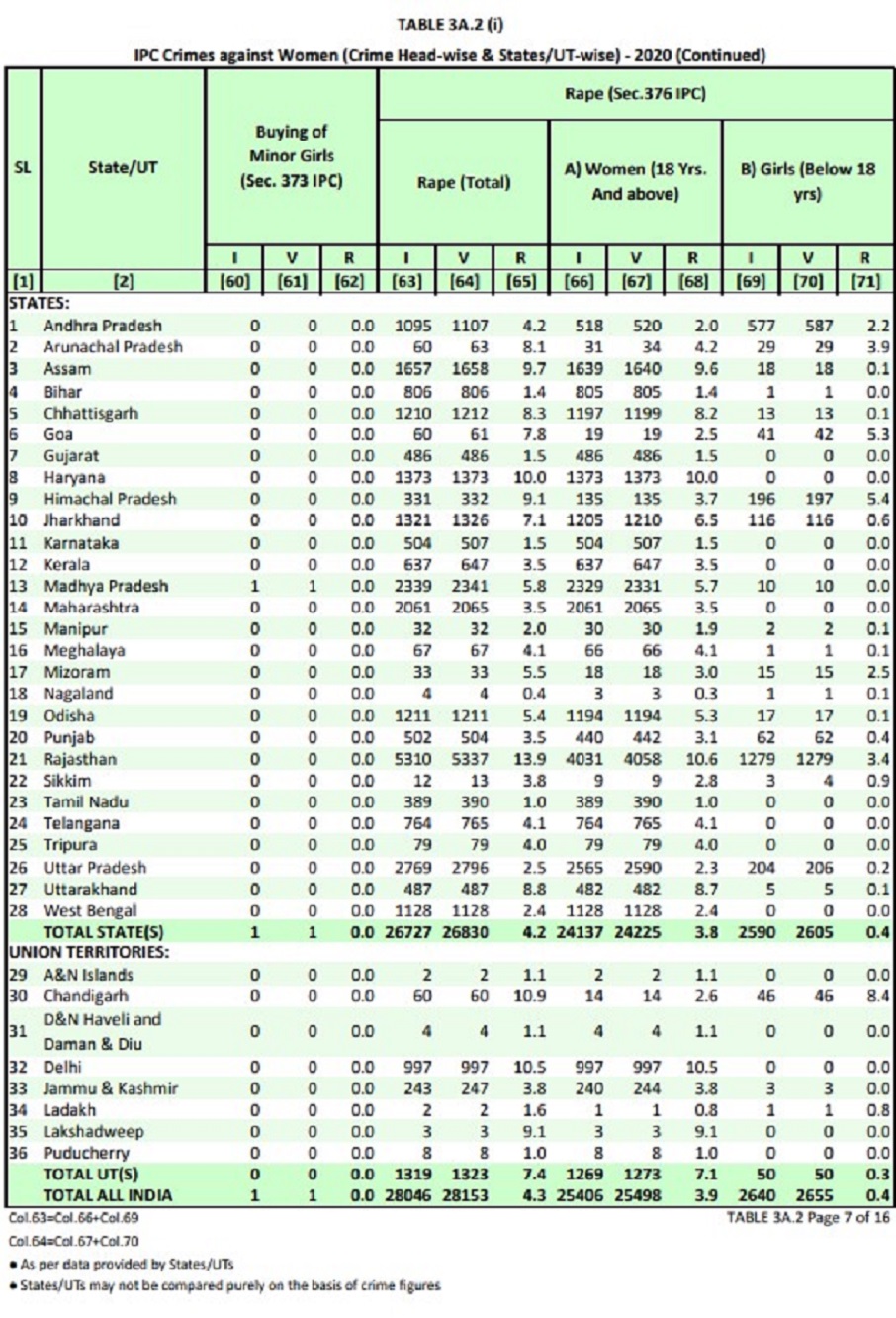
Courtesy National Crime Records Bureau, India
See graphic “Rape in India state-wise, 2020”
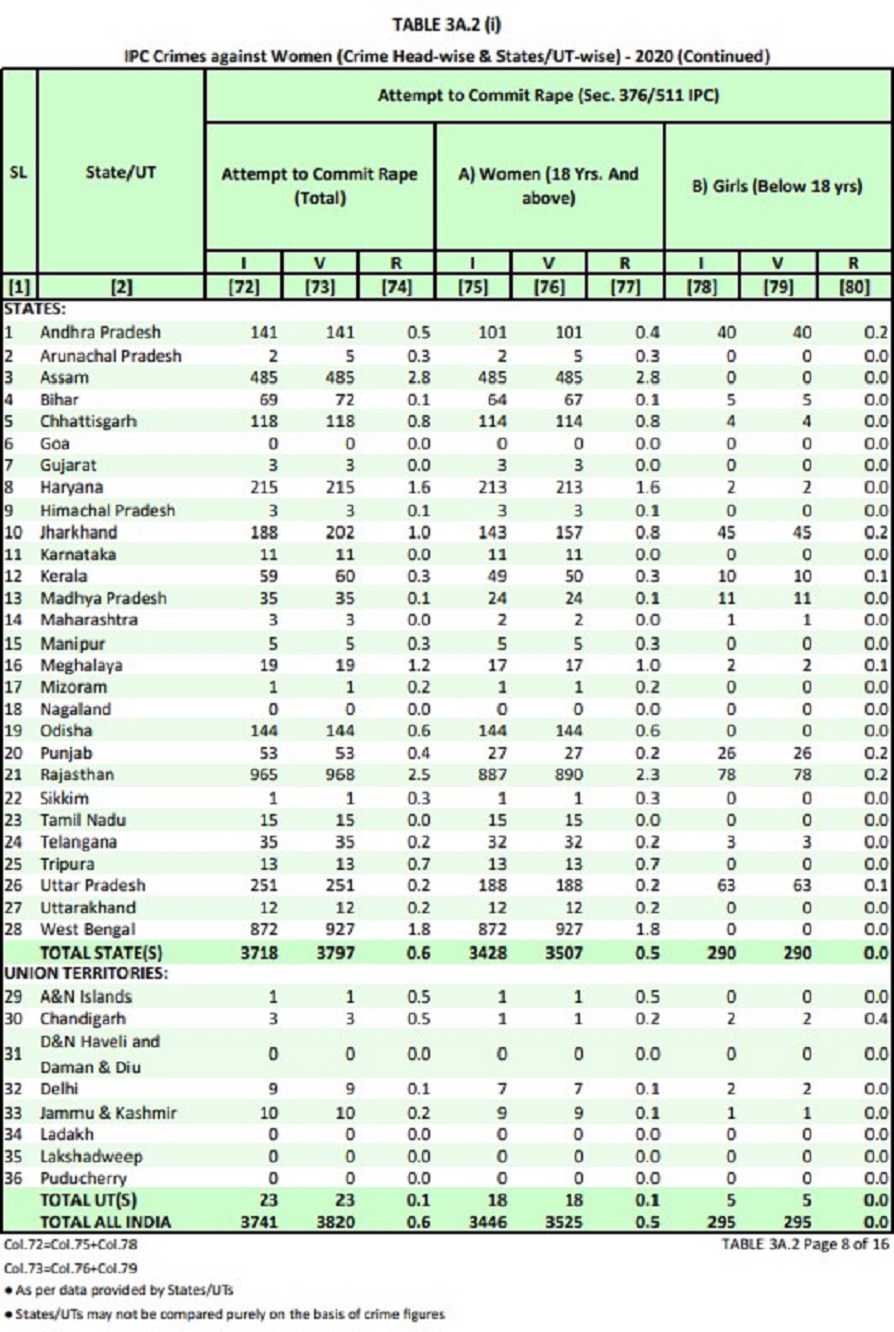
Source: National Crime Records Bureau, India
See graphic “Attempts to rape in India state-wise, 2020”
Indpaedia’s notes: bb The letters I, V, and R in the statistics provided by the National Crime Records Bureau of India stand for:
I = Incidence: This is the number of cases registered under a particular crime head.
V = Victims: This is the number of people who have been victimized by a particular crime.
R = Rate: This is the crime rate per lakh population. It is calculated by dividing the number of cases registered by the population of a state or union territory.
For example, if there are 100 cases of murder registered in a state with a population of 10 lakhs, the crime rate for murder in that state would be 1.0.
The NCRB publishes these statistics every year to provide a comprehensive overview of crime in India. The data is used by policymakers, researchers, and law enforcement agencies to track trends in crime and to develop strategies to prevent crime.
Here are some other terms that you might encounter in NCRB statistics:
Crime head: This is a category of crime, such as murder, rape, or theft.
State/UT: This refers to a state or union territory in India.
Year: This refers to the year in which the crime was committed.
Population: This refers to the population of a state or union territory.
Crime rate: This is the number of cases registered per lakh population.
Delhi: 95% of cases solved
Sakshi Chand, February 20, 2021: The Times of India
The year 2020 was comparatively safer for women with cases of rape, molestation and kidnapping witnessing a decline compared with the previous year. Cases of sexual assault on minors also saw a dip, crime data showed. Police were quick in making arrests and nabbing the culprits, 95% of rape cases were solved. The conviction rate in 2019 was 23% compared with 28% across the country.
In all, 1,699 rape cases were registered in 2020 compared with 2,168 cases in 2019. Similarly, cases registered under Protection of Children from Sexual Offences Act also declined. In 2019, 109 cases under Pocso Act were reported compared with 65 last year and 90% of the cases were solved. The conviction rate of such cases was 68%, higher than the all India rate of 35%.
Several measures were taken to curb crime against women and a round-the-clock women’s desk was set up at all police stations. Apart from this, there were strict instructions to register FIRs even if there were jurisdiction issues. A zero FIR was registered and later transferred to the respective state or city.
Only 1.8% strangers were involved in rape cases compared with 2.2% in 2019 and 3.6% in 2016. The maximum number of rape cases, around 70%, were committed by family, friends, known people and acquaintances, 14% by relatives and 12% by neighbours.
Women officers were appointed for investigation of sexual offence cases, examination of scene of crime by the district crime team and advance crime team for collection of scientific evidence. Apart from this, psychological, legal and medical aid was granted by crisis intervention centres having representation from police, doctors, Delhi Commission for Women and Delhi State Legal Services Authority.
One of the major reasons for a good conviction rate was improved DNA and chemical examination facilities. Reports in rape and Pocso cases were filed within 60 days in 2020 and 78% of cases were chargesheeted within the stipulated time.
Hotspots and dark stretches were identified and CCTV cameras installed there. The most affected police stations were Bindapur, Dwarka North and South, Sagarpur, New Usmanpur, Sultanpuri, Nihal Vihar, Prem Nagar, among others.
PART B
Infamous cases
Delhi: 2008-19
NIRBHAYA — 2012
A crime so horrific that it shook the entire country, not just Delhi, where it took place. The December 2012 gang rape, and the eventual death, of a young woman in a moving bus at night changes in rape laws. As the laws were made more stringent, fast track courts were set up to hear rape cases.
After the arrest of six men, one of them a juvenile, Delhi Police charged the five adult accused with murder, rape, attempt to murder, kidnapping, unnatural offences and dacoity. Later, Ram Singh, one of the accused, died in jail, apparently by suicide.
In 2013, a fast track court found the men guilty and awarded them capital punishment. This was confirmed by Delhi high court’s the same year. When the men appealed to the Supreme Court, it stayed their execution in 2014. Two years later, the court heard their appeals and dismissed them a year later. 2018 saw the apex court dismissing the review petitions of three convicts, the fourth, Akshay, having declined to file a review petition.
The four have not been executed because any court issuing the black warrant to carry out the hanging has to await a decision on a mercy plea filed by Vinay Kumar Sharma to the President of India. Nirbhaya's parents recently moved the trial court seeking to fast-track the death penalty. They told the court that none of the four guilty men had a clemency or curative application pending before the Supreme Court.
SOUMYA VISHWANATHAN — 2008
Television journalist Soumya Vishwanathan was shot dead on September 30, 2008, when driving home from work late at night. The police charged three men for the crime, who were subsequently convicted in the murder of IT professional Jigisha Ghosh in Delhi in 2009.
The trial is currently pending before a sessions judge in the Saket district court. Earlier this year, Delhi high court ordered the court to expedite the trial and directed it to hear the case at least twice every week. But with the trail under way, the high court allowed Ravi Kapoor’s release on parole though it was stayed by the Supreme Court in July.
JIGISHA GHOSH — 2009
Info-tech professional Jigisha Ghosh worked in Noida. She was abducted and killed on March 18, 2009, soon after she was dropped by her office cab at 4am near her home in Vasant Vihar in South Delhi. Her body was recovered three days later from a place near Surajkund in Haryana. The accused had taken her gold ornaments, two mobile phones and her debit and credit cards.
Three men were arrested and a trial court awarded death to two of them, Ravi Kapoor and Amit Shukla, in 2016, while sentencing Baljeet Malik to life in prison. However, a year later Ghosh’s family and prosecution suffered a setback when Delhi high court commuted the death penalty to a life sentence for Kapoor and Shukla while confirming Malik’s life term.
Even as the case awaits the Supreme Court’s final decision, Delhi government earlier this year opposed parole to Kapoor, terming him a “hardened criminal” who is also facing trial in the Soumya Vishwanathan murder case.
CITY-/ REGION- WISE TRENDS
Mumbai: 2013-18
Nitasha Natu, March 6, 2019: The Times of India
The tony areas of Worli, Byculla, Colaba and Malabar Hill in south Mumbai saw the biggest spike in rape cases (172%) from 2013-14 to 2017-18, according to a white paper released by NGO Praja on Tuesday. North Mumbai comprising Dahisar, Borivli and Malad West saw the biggest increase in cases of molestation (186%) during the period. Activists said the high figures could be a result of more women coming forward to lodge complaints.
“It is no more a taboo to report a crime. Women are willing to take a stand and not let the offender get off. This could explain the surge in cases of molestation. A spike in figures for rape could be the result of more reporting of intimate relationships between teenagers. These would be legally recorded as rape, since a girl less than 18 years old does not have the capacity to consent as per law,” Nandita Shah, co-director at Akshara, a women’s resource centre, said. “Overall, the gender equality environment does not exist. Violence has increased, reporting of crimes has increased, and so has reporting of teenage relationships as rape,” Shah added.
Data gathered by Praja showed an increase in child sexual abuse cases under the Pocso Act, from 891 cases in 2015-16 to 1,062 in 2017-18. In both these years, female victims were far greater in number than male victims. “Even the slightest rise in this number is alarming as it shows the city is becoming unsafe for children. It is necessary to create awareness with all stakeholders, i.e. children, families, schools and colleges,” said Nitai Mehta, founder of Praja Foundation.
In 2015, ex-DGP Sanjeev Dayal had ordered separation of investigation units from law and order units at police stations. Praja’s analysis found a shortage in strength of police personnel tasked with investigation, i.e., from the rank of assistant police commissioner up to the constabulary. “There is a shortage of 22% between the sanctioned and working strength of policemen in 2018. We also found a serious shortage in strength of permanent public prosecutors. While the sanctioned strength is 15, only 2 permanent PPs are working,” said Yogesh Mishra of Praja. Permanent prosecutors have been able to get 27% convictions, while those in contractual positions have got 31% as on December 2017, the data showed. “A shortfall in strength of investigating officers as well as PPs would affect conviction rates,” Mishra added.
“If there is increase in reporting of rape and molestation cases, it means more people are coming forward to give complaints. Increase in registration should be taken as a positive as it shows openness and friendliness of the police among the public. The increase in registration should be appreciated. As far as shortage of manpower goes, Mumbai has more than 50,000 police personnel out of 2.2 lakh personnel in Maharashtra. Across India, Mumbai has the highest public-police ratio,” said city police spokesperson DCP Manjunath Shinge.
See also
Age of consent in India Crimes against women: India Juveniles, benefits and privileges of Juvenile delinquency in India Especially the section 'Rape by juveniles' Premarital sex
...Other articles about rapes in India
Rape in India: longer- term statistics, analyses<> Rapes in India: court verdicts<> Rape definitions unique to India<> Rapes in India: the legal position after 2013 <>Rapes in India: Compensation and help for survivors <>Rapes in India: annual statistics
Sexual harassment/ #MeToo
Indpaedia's #MeToo page is called
Sexual harassment in India's media, entertainment, advertising industries; academics